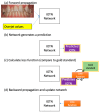Artificial Intelligence for Predicting the Aesthetic Component of the Index of Orthodontic Treatment Need
- PMID: 39329602
- PMCID: PMC11428575
- DOI: 10.3390/bioengineering11090861
Artificial Intelligence for Predicting the Aesthetic Component of the Index of Orthodontic Treatment Need
Abstract
The aesthetic component (AC) of the Index of Orthodontic Treatment Need (IOTN) is internationally recognized as a reliable and valid method for assessing aesthetic treatment need. The objective of this study is to use artificial intelligence (AI) to automate the AC assessment. A total of 1009 pre-treatment frontal intraoral photos with overjet values were collected. Each photo was graded by an experienced calibration clinician. The AI was trained using the intraoral images, overjet, and two other approaches. For Scheme 1, the training data were AC 1-10. For Scheme 2, the training data were either the two groups AC 1-5 and AC 6-10 or the three groups AC 1-4, AC 5-7, and AC 8-10. Sensitivity, specificity, positive predictive value, negative predictive value, and accuracy were measured for all approaches. The performance was tested without overjet values as input. The intra-rater reliability for the grader, using kappa, was 0.84 (95% CI 0.76-0.93). Scheme 1 had 77% sensitivity, 88% specificity, 82% accuracy, 89% PPV, and 75% NPV in predicting the binary groups. All other schemes offered poor tradeoffs. Findings after omitting overjet and dataset supplementation results were mixed, depending upon perspective. We have developed deep learning-based algorithms that can predict treatment need based on IOTN-AC reference standards; this provides an adjunct to clinical assessment of dental aesthetics.
Keywords: Index of Orthodontic Treatment Need; aesthetic component; artificial intelligence.
Conflict of interest statement
The authors declare no conflicts of interest.
Figures







Similar articles
-
Evaluation of different aesthetic indices for planning orthodontic treatment.Bioinformation. 2023 Dec 31;19(13):1394-1398. doi: 10.6026/973206300191394. eCollection 2023. Bioinformation. 2023. PMID: 38415035 Free PMC article.
-
[Orthodontic treatment needs and indications assessed with IONT].Ann Acad Med Stetin. 2004;50(1):115-22. Ann Acad Med Stetin. 2004. PMID: 16871750 Polish.
-
Digital images as an alternative to orthodontic casts in assessing malocclusion and orthodontic treatment need.Acta Odontol Scand. 2007 Nov;65(6):362-8. doi: 10.1080/00016350701771850. Acta Odontol Scand. 2007. PMID: 18071959
-
An investigation into the reliability of a mobile app designed to assess orthodontic treatment need and severity.Br Dent J. 2022 May;232(10):721-726. doi: 10.1038/s41415-022-4246-2. Epub 2022 May 27. Br Dent J. 2022. PMID: 35624263 Free PMC article.
-
Agreement between orthodontist and patient perception using Index of Orthodontic Treatment Need.Saudi Dent J. 2014 Oct;26(4):156-65. doi: 10.1016/j.sdentj.2014.03.004. Epub 2014 May 4. Saudi Dent J. 2014. PMID: 25382948 Free PMC article.
References
-
- BMA; 2022. [(accessed on 15 February 2023)]. An NHS under Pressure. Available online: https://www.bma.org.uk/advice-and-support/nhs-delivery-and-workforce/pre....
-
- British Orthodontic Society; 2021. [(accessed on 15 February 2023)]. The ‘Zoom Boom’: BOS Stats Reveal a Surge in Demand for Orthodontics during the Pandemic. Available online: https://www.dentalreview.news/dentistry/21-orthodontic/7269-bos-reports-....
-
- Price J., Whittaker W., Birch S., Brocklehurst P., Tickle M. Socioeconomic disparities in orthodontic treatment outcomes and expenditure on orthodontics in England’s state-funded National Health Service: A retrospective observational study. BMC Oral Health. 2017;17:123. doi: 10.1186/s12903-017-0414-1. - DOI - PMC - PubMed
-
- Papio M.A., Fields H.W., Beck F.M., Firestone A.R., Rosenstiel S.F. The effect of dental and background facial attractiveness on facial attractiveness and perceived integrity and social and intellectual qualities. Am. J. Orthod. Dentofac. Orthop. 2019;156:464–474.e1. doi: 10.1016/j.ajodo.2018.10.021. - DOI - PubMed
LinkOut - more resources
Full Text Sources

